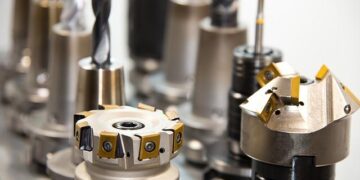February 9, 2024
6 min read
Rather than ripping up our fundamental models of the universe, the unexpectedly big and bright galaxies spied in the early universe by JWST probably have astrophysical explanations
By Jonathan O’Callaghan

Bursts of star formation sparked by supermassive black holes interacting with giant gas clouds could help explain a mysterious and unexpected abundance of big, bright galaxies in the early universe.
Credit:
Roberto Molar Candanosa/JHU
Ever since it opened its giant infrared eye on the cosmos after its December 2021 launch, the James Webb Space Telescope (JWST) has found a shocking surfeit of bright galaxies that stretch back to the very early universe. Their brightness—a proxy for their numbers of stars and hence their mass—is deeply puzzling because galaxies shouldn’t have had enough time to become so bulky in such early cosmic epochs. Imagine visiting a foreign land and finding that many of its toddlers weighed as much as teenagers. You might have questions, too: Is the cause of such large children something in the water, or might it instead be that your grasp of human growth is fundamentally flawed? Theorists who pondered JWST’s big, bright early galaxies felt much the same: Was something fundamental amiss in our understanding of cosmology? Namely, was our knowledge of the expansion of the universe following the big bang simply wrong?
The answer, it appears, need not be quite so dramatic.
Investigating some of these early galaxies, several studies now point more toward an astrophysical explanation for the unexpected girth—such as earlier-forming black holes or bursts of star formation—rather than some physics-shattering result. “Most people would put their money on the astrophysical explanation right now,” says Mike Boylan-Kolchin, a cosmologist at the University of Texas at Austin. “I’d count myself in that category as well.”
On supporting science journalism
If you’re enjoying this article, consider supporting our award-winning journalism by subscribing. By purchasing a subscription you are helping to ensure the future of impactful stories about the discoveries and ideas shaping our world today.
Before JWST’s debut, its predecessor, the Hubble Space Telescope, held the record for the earliest galaxy ever found. We see that object, called GN-z11, as it was about 13.4 billion years ago, around 400 million years after the big bang. As soon as JWST turned its gaze onto the universe, however, it repeatedly smashed Hubble’s record. We now study galaxies stretching back to at least 320 million years after the big bang. And later this year, fresh data releases from ongoing JWST galaxy surveys should push this record back even further.
JWST’s earliest-seen galaxies were brighter and more active than expected, with star formation rates comparable to the one-star-per-year rate of our Milky Way today. But they were squeezed into much more compact sizes, around 1,000 times smaller than our galaxy. And as JWST delved deep into the early universe, it also examined a somewhat later swath of cosmic history up to about 750 million years after the big bang. The older galaxies it found there were still quite young and strange: they were up to 30 times smaller than the Milky Way (100 times bigger than expected) and had star formation rates that must have been 1,000 times higher than our own. Scientists dubbed these relatively older systems ultramassive galaxies and kept scratching their heads: neither set of galaxies could be wholly explained by our current models.
Today in the journal Physical Review Letters, Nashwan Sabti of Johns Hopkins University (JHU) and his colleagues have proposed a solution for JWST’s ultramassive galaxies. They used existing data from Hubble to examine hundreds of galaxies in ultraviolet light in the same epoch of the universe as these galaxies, about 450 to 750 million years after the big bang. Unlike JWST, which primarily observes in infrared, Hubble is sensitive to the ultraviolet (UV) end of the electromagnetic spectrum, where young massive stars blaze brightest. Hubble’s UV observations allowed the researchers to better gauge the rates of star formation in the mysterious ultramassive galaxies. “So we have the star formation rate—the change in stellar mass over time—versus the stellar mass itself from JWST,” Sabti says.
Comparing those two pieces of information, Sabti and his colleagues found that the galaxies could be explained within the confines of our cosmological model of the universe: the Lambda Cold Dark Matter (Lambda-CDM) model, which best replicates the observed patterns and properties of galaxies and other large cosmic structures. No esoteric physics were required. In fact, any such tweaks would put the Hubble observations at odds with JWST; the galaxies were growing exactly as expected in accordance with Lambda-CDM’s predictions. “We showed that Hubble really doesn’t give you much wiggle room to play around with cosmology,” Sabti says. “That means the source [of the ultramassive galaxies] is very likely astrophysics.”
Boylan-Kolchin says the paper makes a “great point” in comparing Hubble and JWST data from this period of the universe. He isn’t completely convinced just yet, however. “I don’t think the case is airtight that it has to be an astrophysical explanation,” he says. “The loophole is: you’re not necessarily observing the same galaxies with JWST and Hubble. Galaxies can be luminous [in infrared] for JWST but invisible for Hubble. If the most massive ones happen to be in that [infrared] regime, then maybe Hubble wouldn’t be seeing them.”
Sabti’s paper is not the only recent work that points toward an astrophysical explanation for JWST’s peculiar galaxies, however. In the Astrophysical Journal Letters last month, Joseph Silk of JHU and Sorbonne University in Paris and his colleagues looked at the earliest galaxies seen by JWST, which predate GN-z11. The researchers wrote that there might be a way to grow the galaxies more quickly in the universe if black holes formed earlier than the galaxies themselves, within the first 50 million years after the big bang. That could explain why star formation rates in the early universe were so high: the black holes could have powered the galaxies earlier than expected and crushed clouds of dust and gas into stars more quickly in reasonably well-understood astrophysical processes called feedback and outflow.
“There are far more black holes than we expected” in JWST’s observations, Silk says, “and the galaxies they’re in are very compact,” barely 300 light-years across, compared with our Milky Way’s diameter of 100,000 light-years. “This means the feedback is greatly enhanced,” Silk says. “Our basic hypothesis is that the black holes really formed before most of the stars, and their vigorous outflows then created lots of stars. As time went on, this died away and led to the more conventional star formation that we have [today]. We think this is just a very special phenomenon that occurred early on and can explain the mysteries that we’re seeing with Webb.”
Fabio Pacucci of the Center for Astrophysics | Harvard & Smithsonian and his colleagues have studied the role black holes may have played at a later time in galaxies’ evolution. In a galaxy like our own in the modern universe, the mass of stars outweighs the mass of the galaxy’s central supermassive black hole—a feature that is ubiquitous to large galaxies—by a ratio of 1,000 to 1. Examining the period 750 million to 1.5 billion years after the big bang observed by JWST, Pacucci found that some galaxies in this period may have a black hole whose mass matches their stellar mass—or perhaps even exceeds it. That points to a model of black hole growth in the early universe in which black holes grew from the direct collapse of clouds of dust and gas in the first 100 million years of the cosmos rather than from stars. This result is consistent with that of Silk and his colleagues and thus may bolster the astrophysical explanation of the rapid early growth of galaxies.
If that idea is correct, upcoming gravitational-wave observatories—such as the Laser Interferometer Space Antenna (LISA) space observatory, which was recently approved by the European Space Agency and set for launch in 2035—might find these “heavy seed” black holes. “If these heavy seeds happened, then we would see a lot of mergers” with LISA, Pacucci says. “It’s possible this will ease the excessive mass problem.”
There are ways to explain JWST’s galaxies without black holes, too. Guochao Sun of Northwestern University and his colleagues have suggested that some galaxies in the universe may have gone through periods of “bursty” star formation. An abundance of supernovae could have temporarily led to a feedback process over 10 million years or so that increased star formation to rates “10 to 100 times” higher than those of more sedate galaxies, Sun says. That could have caused the brightness of some galaxies in the early universe to “jump up and down very drastically,” leading to a skewed sample of more visible bright galaxies. “You don’t need to form stars at a very high efficiency,” Sun adds. It may be that JWST’s mysteriously bright early galaxies merely represent the upper end of dramatic fluctuations in star formation, with dimmer, more prosaic galaxies being more numerous but as yet unseen.
Astrophysics, for the time being, reigns supreme. There is much at stake, however. “The fact that cosmology could be at play here means it’s really worth following it up until it’s excluded,” Boylan-Kolchin says. Black holes and star formation make for promising explanations so far. But scientists will be watching for fresh JWST results to see which, if any, of these new models holds firm.
>>> Read full article>>>
Copyright for syndicated content belongs to the linked Source : Scientific American – https://www.scientificamerican.com/article/jwsts-puzzling-early-galaxies-dont-break-cosmology-but-they-do-bend-astrophysics/































